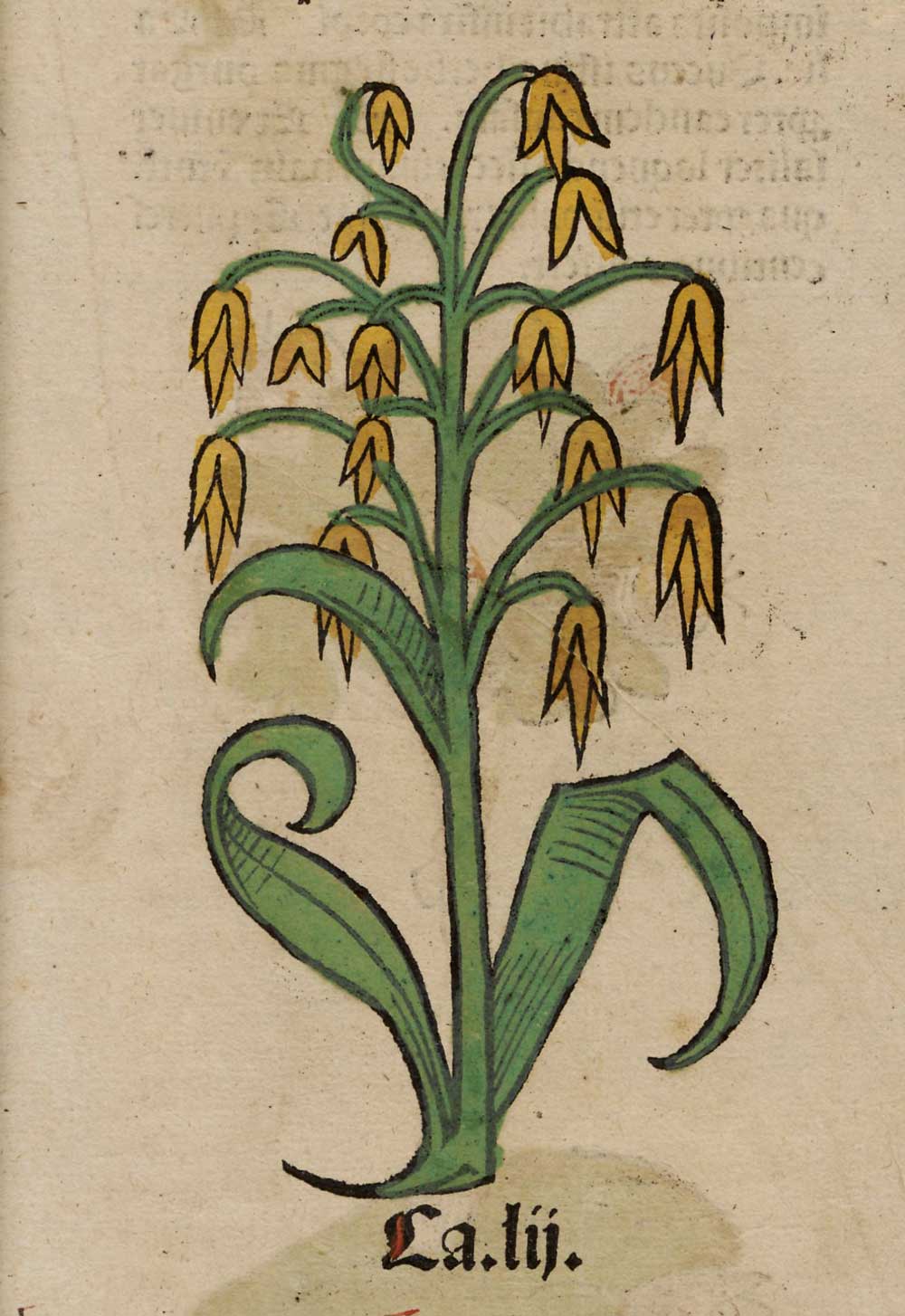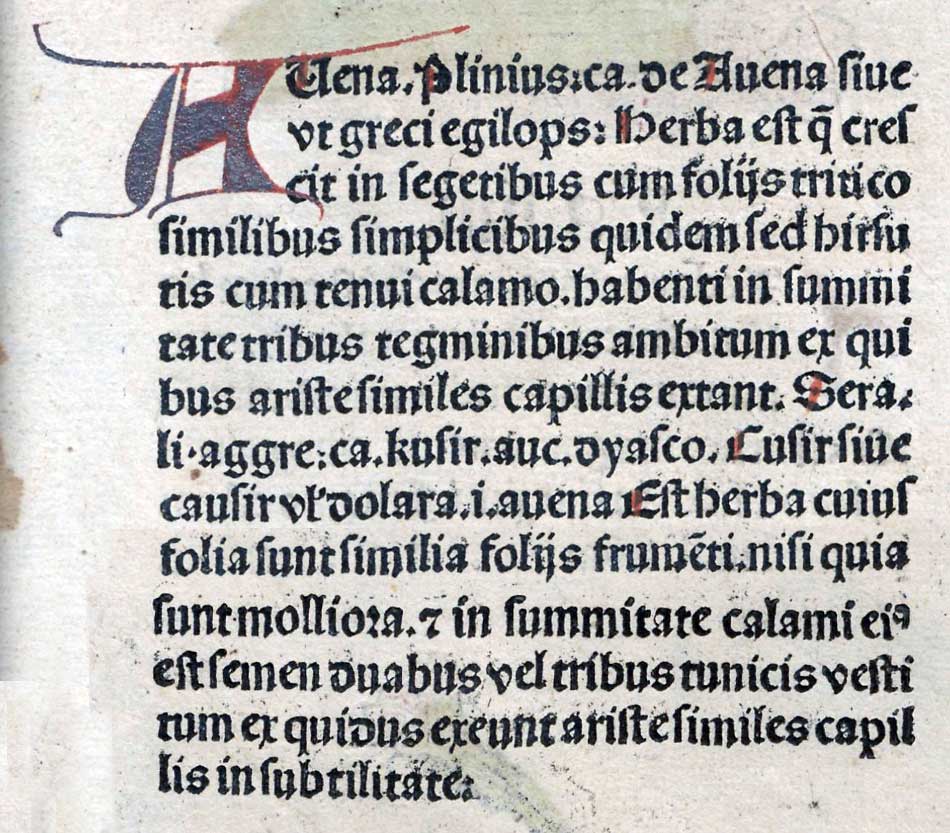Among the examples of pairings whose antipathies are not as vehement as the hatred thieves have of a certain usage of Pantagruelion.
The section from “La presle aux fauscheurs” (horse-tail to mowers) to “le Lierre aux Murailles” (ivy to walls), including this phrase, was added in the 1552 edition.
Notes
Avena
Avena (text)
axe-weed
But no kind can change altogether into another, except one-seeded wheat and rice-wheat, as we said in our previous discussions, and darnel which comes from degenerate wheat and barley: at least, if this is not the true account, darnel loves chiefly to appear among wheat, as does the Pontic melampyros and the seed of purse-tassels, even as other seeds appear in other crops; thus aigilops seems to grow for choice among barley, and among lentils the rough hard kind of arakos, while among tares occurs the axe-weed,1 which resembles an axe-head in appearance.
Note 1. Plin. 18. 155; 27. 121; Diosc. 3. 130; Hesych. s.v. βέλλεκυς.
aegilops
Veneficiis rostrum lupi resistere inveteratum aiunt ob idque villarum portis praefigunt. hoc idem praestare et pellis e cervice solida manica existimatur, quippe tanta vis est animalis praeter ea quae retulimus ut vestigia eius calcata equis adferant torporem.
Sorceries are said to be counteracted by a wolf’s preserved muzzle, and for this reason they hang one up on the gates of country houses. The same effect is supposed to be given by the whole fur from a wolf’s neck, the legs included, for so great is the power of the animal that, besides what I have already stated, his footprints when trodden on by horses make them torpid.
aegilops
Aegilopas sanat herba eodem nomine quae in hordeo nascitur, tritici folio, semine contrito cum farina permixta inpositaque vel suco. exprimitur hic e caule foliisque praegnantibus dempta spica et in trimestri farina digeritur in pastillos.
Aegilops [Aegilops the disease is a lacrimal fistula] is cured by the plant of the same name, which grows among barley and has a leaf like that of wheat; either the seed may be reduced to powder, mixed with flour and applied, or the juice may be used. This is extracted from the stem and juicy leaves after taking away the ears, and then it is worked into lozenges with the flour of three-month wheat.
aegilops
e glandiferis sola quae vocatur aegilops fert pannos arentes, muscoso villo canos, non in cortice modo verum et e ramis dependentes cubitali magnitudine, odoratos, uti diximus inter unguenta.
Of the acorn-bearing tree the one called the aegilops alone carries strips of dry cloth [Some kind of lichen is referred to on the Turkey oak] covered with white mossy tufts; this substance not only grows on the bark but hangs down from the branches in streamers eighteen inches long, and it has a strong scent, as we said when dealing with perfumes.
orobanche
Est herba quae cicer enecat et ervum circum-ligando se, vocatur orobanche; tritico simili modo aera, hordeo festuca quae vocatur aegilops, lenti herba securiclata quam Graeci a similitudine pelecinum vocant; et hae conplexu necant.
There is a weed that kills off chick-pea and bitter vetch by binding itself round them, called orobanche [‘Vetch-strangler.’ Not the modern botanists’ orobanche or broom-rape but plants such as dodder and bindweed]; and in a similar way wheat is attacked by darnel, barley by a long-stalked plant called aegilops and lentils by an axe-leaved plantb which the Greeks call axe-grass from its resemblance; these also kill the plants by twining round them.
æglyops
La coquiole, qui fait mourir l’orge.
egylops
La coquiole.
Aegilops (Darnel) to Barley
Pliny xviii. 17, § 44 (155)
aegilops a l’orge
«Hordem [enecat] festuca quæ vocatur ægilops,» dit Pline, XVIII, 44. Il s’agit ici pour Fée, de l’Ægylops ovata, L., qui naît au milieu de l’orge («in hordeo nascitur,» Pline, XXV, 93), la refoule et l’etouffe. Dalechamps et le P. Hardouin ont voulu y reconnaître notre Avena sterilis, L. Hugues de Solier, dans ses Scholies sur Aétius, rapporte également l’Ægylops au Sivado freo des Provençaux (A. sterilis, L.) Enfin pour Ch. Estienne ce serait la folle avoine ou Havron des paysans: autrement dit notre Avena fatua, L. (Paul Delaunay)
orobanche, aegilops, securidaca, antranium, l’yvraye
Les cinq exemples suivants sont tous empruntés au même chapitre de Pline (XVIII, 44) (LD).
ægilops
ægilops [Latin ægilops, adopted from Greek aigilwy, formed on aic, aigoj, a goat, aigiloj, a herb eaten by goats + wy eye, face.]
An ulcer or fistula in the inner angle of the eye.
1601 Philemon Holland, translator Pliny’s History of the world, commonly called the Natural historie (1634) II. 234 There is a running betweene the corner of the eie and the nose, called Ægilops; for to heale which sore, there is a soueraigne herbe of that name growing among Barly.
1751 Ephriam Chambers Cyclopædia; or, an universal dictionary of arts and sciences s.v., If the Ægilops be neglected, it bursts, and degenerates into a fistula which eats into the bone.
The wild-oat or other grass found as a corn-weed. Obsolete
1706 Phillips, Ægilops: a Weed that grows amidst Corn, Darnel, Wild Oats.
1753 Ephriam Chambers Cyclopædia; or, an universal dictionary of arts and sciences. Supplement s.v., The ægilops is the avena sylvestris, the wild oat.

